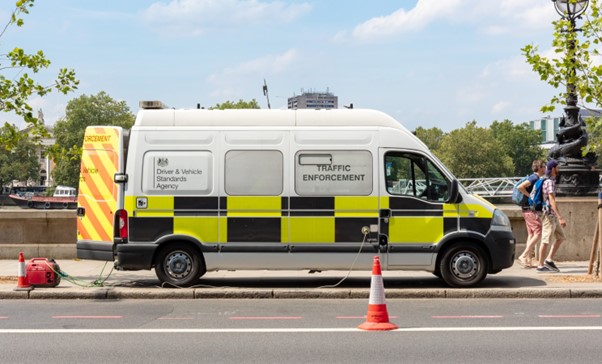
Susie Jones
Explication des contrôles DVSA pour les poids lourds
Créée: 08/08/2024
•
Mise à jour : 08/08/2024
Au cours de votre carrière de conducteur de camion, il se peut que vous soyez contrôlé par la Driver and Vehicle Standards Agency (DVSA). Pour les chauffeurs de camions qui débutent dans le secteur, ce processus peut être décourageant. Cependant, comprendre les aspects essentiels des contrôles des camions par la DVSA peut rendre le processus moins stressant.
Qui est la DVSA ?
Selon [Gov.uk] (http://gov.uk/), la DVSA est chargée de "réaliser des contrôles routiers sur les conducteurs et les véhicules commerciaux afin de s'assurer qu'ils respectent les règles de sécurité et que leur véhicule peut être conduit en toute sécurité".
La DVSA peut effectuer des contrôles ponctuels sur votre camion et émettre des interdictions. Les interdictions empêchent un chauffeur de camion de conduire jusqu'à ce que le problème concernant son véhicule soit résolu.
La police est également habilitée à arrêter un chauffeur de camion et à effectuer des contrôles similaires.
A quoi ressemblent les examinateurs de la DVSA ?
Il y a plusieurs façons d'identifier un examinateur de la DVSA. Ils portent des gilets de visibilité jaunes avec le logo DVSA et sont toujours munis d'une carte de mandat. Leurs véhicules sont imprimés en noir et jaune avec le logo DVSA sur le capot.

Que se passe-t-il si vous vous faites arrêter ?
Le fait de ne pas s'arrêter lorsqu'un examinateur du DVSA vous le demande constitue une infraction. Si un examinateur vous demande de vous arrêter, il effectuera le contrôle sur le bord de la route ou sur un site d'examen spécifique. L'objectif principal de ces contrôles est d'empêcher les véhicules dangereux de circuler sur la route.
Un examinateur effectuera les contrôles obligatoires suivants :
Vérification du poids de la charge autorisée et du type de charge
Contrôle des défauts mécaniques et de l'aptitude à la circulation
S'assurer que les enregistrements du tachygraphe sont corrects
Assurez-vous d'être en possession d'un permis de conduire valide.
Combien de temps dure un contrôle de la DVSA ?
En moyenne, un contrôle de la DVSA dure 15 minutes. Toutefois, si le camion ne répond pas aux exigences de sécurité, le contrôle peut durer plus longtemps. L'examinateur doit effectuer les contrôles nécessaires, indépendamment du temps.
Comment s'assurer que son véhicule est en état de marche ?
Il incombe au conducteur de s'assurer que son camion est en état de marche. Il est recommandé d'effectuer un contrôle avant chaque voyage.
Vérifier les éléments suivants :
Feux
Indicateurs
Carburant et huile
Pneus
Fixations des roues
Travail corporel
Attelage de remorque
Chargement et autres équipements
Contrôles des véhicules en cabine (par exemple, ceintures de sécurité, klaxon, essuie-glaces, lave-glaces, direction et indicateur de hauteur).
En outre, il incombe au conducteur de signaler par écrit tout défaut à son organisation. Ces rapports doivent contenir les éléments suivants :
Marque d'immatriculation ou d'identification du véhicule
Date de l'inspection
Détails des défauts
Nom de la personne qui signale les défauts.
Responsabilités de l'opérateur
Les conducteurs de véhicules sont responsables de la sécurité de leurs véhicules et doivent effectuer les opérations suivantes :
L'exploitant doit veiller à ce que tous les véhicules commerciaux fassent l'objet d'inspections de sécurité régulières.
Ils doivent s'assurer que leurs conducteurs comprennent les vérifications à effectuer.
Interdictions routières
Si votre camion n'est pas en état de rouler, la DVSA peut vous délivrer deux avis d'interdiction différents : immédiat ou différé.
Avis d'interdiction immédiate :
Elle peut entrer en vigueur immédiatement
Dans la plupart des cas, elle entraîne l'immobilisation du véhicule.
Les interdictions immédiates peuvent donner lieu à des poursuites judiciaires.
Avis d'interdiction différée :
L'opérateur a jusqu'à 10 jours pour résoudre les problèmes.
Après dix jours, les agents réinspecteront le véhicule
Les interdictions doivent être levées avant que le camion puisse être conduit.
Interdictions de circuler
Si le camion présente des problèmes mécaniques ou si la carrosserie et l'équipement sont de mauvaise qualité, une interdiction de circuler est prononcée. Pour les véhicules circulant en dehors du Royaume-Uni, le conducteur se verra infliger une interdiction immédiate. Pour les opérateurs britanniques, le type d'interdiction dépend de la gravité du défaut.
Défauts mineurs :
Des défauts mineurs peuvent entraîner une interdiction différée
L'opérateur dispose d'un délai de dix jours pour résoudre les problèmes éventuels.
Une nouvelle inspection aura lieu après dix jours.
Défauts graves :
Le conducteur recevra une interdiction marquée d'un "S" pour un défaut grave.
Une interdiction marquée d'un "S" se produit lorsqu'il y a un problème de maintenance.
Si l'examinateur décide qu'il n'y a pas de risque immédiat, les interdictions peuvent être retardées.
Le véhicule sera immobilisé et vous risquez des poursuites judiciaires.
Une interdiction marquée d'un "S" ne sera pas appliquée dans les cas suivants :
Si un problème survient pendant le voyage
Le problème n'a pas pu être détecté (par exemple, un défaut de la face inférieure).

Interdictions de surcharge
Si le véhicule est surchargé, un examinateur du DVSA peut l'immobiliser. Il peut également diriger le camion vers un endroit proche où la charge peut être redistribuée ou enlevée. L'opérateur du véhicule recevra un avis.
Interdictions relatives aux heures de conduite
Les conducteurs qui n'ont pas respecté les règles relatives au tachygraphe et aux heures de conduite recevront une interdiction. Cette interdiction peut entraîner une amende, des poursuites judiciaires ou l'immobilisation du véhicule.
Plus d'informations sur [règles et réglementations relatives aux tachygraphes] (https://https://snapacc.com/newsroom/tachograph-rules-made-easy/)
Bien que les examens DVSA puissent être une perspective intimidante pour les conducteurs de camions, ils constituent indéniablement une force positive pour la sécurité routière. En vous assurant que vous avez effectué les contrôles appropriés et que vous respectez les règles et réglementations essentielles, vous passerez l'examen DVSA sans encombre.
Combien de temps devez-vous conserver les fiches de défauts des camions ?
La mise en place d'un système de signalement des défauts peut constituer votre première ligne de défense pour démontrer que vos véhicules sont en état de rouler. Les travaux de rectification des défauts doivent être signalés et conservés pendant 15 mois au maximum. Lorsqu'il n'y a pas de défauts, l'entreprise doit conserver des enregistrements pour s'assurer que les conducteurs effectuent leurs contrôles.
A quelle fréquence devez-vous passer un examen médical pour conserver votre permis ?
Pour obtenir et conserver un permis de conduire un poids lourd, il est obligatoire de passer un examen médical pour poids lourds, sans quoi le permis ne sera pas délivré.
Pour les conducteurs de moins de 45 ans, l'examen médical durera jusqu'à leur 45e anniversaire. Toutefois, après cet âge, vous devrez passer l'examen médical tous les cinq ans jusqu'à l'âge de 65 ans. Les conducteurs de 65 ans et plus doivent passer l'examen médical tous les ans.



